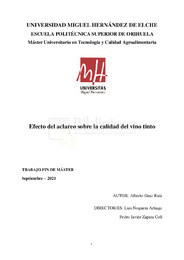Por favor, use este identificador para citar o enlazar este ítem:
https://hdl.handle.net/11000/25494Registro completo de metadatos
| Campo DC | Valor | Lengua/Idioma |
|---|---|---|
| dc.contributor.advisor | Noguera Artiaga, Luis | - |
| dc.contributor.advisor | Zapata Coll, Pedro Javier | - |
| dc.contributor.author | Grao Ruiz, Alberto | - |
| dc.contributor.other | Departamentos de la UMH::Tecnología Agroalimentaria | es_ES |
| dc.date.accessioned | 2021-12-01T07:57:29Z | - |
| dc.date.available | 2021-12-01T07:57:29Z | - |
| dc.date.created | 2021-09 | - |
| dc.date.issued | 2021-09 | - |
| dc.identifier.uri | http://hdl.handle.net/11000/25494 | - |
| dc.description.abstract | El vino es una de las bebidas alcohólicas más consumidas en el mundo y una de las que mayor arraigo social y cultural presenta. De entre sus tipologías, el vino tinto es el producto más elaborado y consumido. En la zona del Mediterráneo español, la variedad con mayor acervo es la Monastrell, que destaca por su elevado nivel de taninos, sus propiedades organolépticas y su facilidad para adquirir una gran cantidad de azúcares. Con el fin de mejorar la calidad de las bayas para, de esta forma, incrementar la calidad del vino obtenido, se aplican muchos tratamientos precosecha. Uno de los más estudiados en los últimos años es el aclareo, que consiste en reducir la carga de bayas o racimos para que la planta redistribuya entre los granos restantes los nutrientes. El objetivo del presente estudio fue evaluar la influencia de la práctica del aclareo sobre la calidad fisicoquímica, sensorial y aromática del vino tinto. Se elaboraron 3 vinos con uva procedente de distinta carga en racimo y se estudió el efecto de la adición de SO2 en la calidad del producto final, mediante el análisis de los parámetros de calidad enológicos (acidez, grado alcohólico, azúcares reductores, etc.), la determinación de la composición volátil mediante cromatografía de gases acoplada a espectrometría de masas, y un análisis sensorial descriptivo mediante un panel entrenado (23 descriptores positivos y 8 defectos). Se detectaron un total de 33 compuestos volátiles y se encontraron diferencias significativas en el análisis sensorial de las fases olfativa, gustativa, global y visual de las muestras, observando que la aplicación de aclareo, ya sea de racimos o de granos, influye positivamente en la calidad sensorial y aromática del vino tinto, favoreciendo la percepción de descriptores clave, como sabores tostados, dulces, especiados y vegetales. Por otro lado, se determinó que las muestras de vino cuyo procesado prescindió de la utilización de SO2 mostraron un perfil sensorial más agradable que las muestras a las que este compuesto se adicionó. | es_ES |
| dc.description.abstract | Wine is one of the most consumed alcoholic beverages in the world and one of those with the greatest social and cultural roots. Among its typologies, red wine is the most elaborated and consumed product. In the Spanish Mediterranean area, the variety with the greatest collection is Monastrell, which stands out for its high level of tannins, its organoleptic properties, and its ease of acquiring sugars. To improve the quality of the berries and thus increase the quality of the wine obtained, many pre-harvest treatments are applied. One of the most studied in recent years is thinning, which consists of reducing the berry load so that the plant redistributes the nutrients among the remaining grains. The objective of the present study was to evaluate the influence of thinning practice on the physicochemical, sensorial, and aromatic quality of red wine. 3 wines were made with grapes from different clusters and the effect of the addition of SO2 on the quality of the final product was studied, by analyzing the oenological quality parameters (acidity, alcoholic degree, reducing sugars, etc.), the determination of the volatile composition by gas chromatography coupled to mass spectrometry, and a descriptive sensory analysis by means of a trained panel (23 positive descriptors and 8 defects). A total of 33 volatile compounds were detected and significant differences were found in the sensory analysis of the olfactive, gustative, global, and visual phases, obtaining that the application of thinning, whether of bunches or grains, positively influences the sensory and aromatic quality of red wine, favoring the perception of key descriptors, such as roasted, sweet, spicy, and vegetable flavors. On the other hand, it was determined that the wine samples whose processing dispensed with the use of SO2 showed a more pleasant sensory profile than those to which this compound was added. | es_ES |
| dc.format | application/pdf | es_ES |
| dc.format.extent | 24 | es_ES |
| dc.language.iso | spa | es_ES |
| dc.publisher | Universidad Miguel Hernández | es_ES |
| dc.rights | info:eu-repo/semantics/openAccess | es_ES |
| dc.rights.uri | http://creativecommons.org/licenses/by-nc-nd/4.0/ | * |
| dc.subject | Análisis sensorial | es_ES |
| dc.subject | Compuestos volátiles | es_ES |
| dc.subject | Cromatografía de gases | es_ES |
| dc.subject | Monastrell | es_ES |
| dc.subject.other | CDU::6 - Ciencias aplicadas::66 - Ingeniería, tecnología e industria química. Metalurgia::663/664 - Alimentos y nutrición. Enología. Aceites. Grasas | es_ES |
| dc.title | Efecto del aclareo sobre la calidad del vino tinto | es_ES |
| dc.type | info:eu-repo/semantics/masterThesis | es_ES |

Ver/Abrir:
TFM Grao Ruiz, Alberto.pdf
1,71 MB
Adobe PDF
Compartir:
 La licencia se describe como: Atribución-NonComercial-NoDerivada 4.0 Internacional.
La licencia se describe como: Atribución-NonComercial-NoDerivada 4.0 Internacional.
.png)